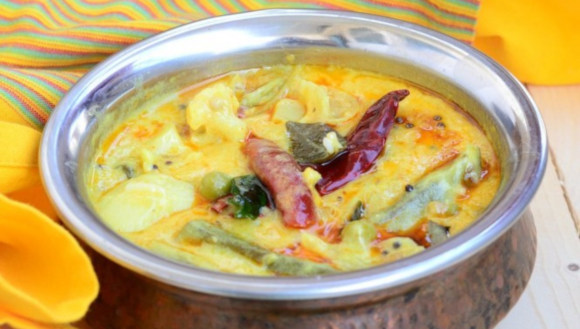Mama’s Punjabi Recipes- PUNJABI BESAN DI KADHI (CHICKPEA FLOUR CURRY)

Some Indian comfort foods are universal as they are simple, taste good and are easy to make, like kadhi. Kadhi is also a great dish to eat with plain rice on a rainy, cold winter day like we have during this time of the year. This is a repeat of a recipe but so appropriate for the Holidays ahead while watching football or movies at home.
Kadhi is a dish that is made all over India with many variations. In some parts of India, they throw minced vegetables in the curry and eat it with boiled rice. Rajasthani and Gujurati kadhi is usually thinner and has a sweet taste. Sindhi kadhi uses imbli (tamarind pulp) to give it the sour taste.
The traditional Punjabi style kadhi is made with thick besan curry and has fried vegetable pakoras (fried fritters) in it with some yogurt to give it a sour taste. It is usually eaten with tandoori roti, paranthas and sometimes with rice.
Besan (roasted gram flour or garbanzo flour or chickpea flour) is a flour that is commonly used all over India to make pakoras, one of the most favorite and easy to make snacks which can be found at almost every street corner halwai or cooking vendor. The flour, when mixed with a few spices, adds zest as batter for vegetables and it is just a delight to eat hot pakoras – never mind that they are fried! Pakoras are, after all, Indian comfort food.
Besan is high in carbohydrates and somewhat high in protein but has no gluten, which makes it unsuitable for those trying to lose weight (especially when it is fried).
Besan has many uses in cooking. You can make boondi (besan fried droplets) to put in dahi (yogurt) or to make laddus (sweet balls) – either fried dripped in syrup or those made of roasted, sweetened flour – or simply besan ki barfi (sweetened flat cake) or pooda (a flat bread)
Punjabi kadhi tastes best when made with plain pakoras instead of those stuffed with vegetables in them
Ingredients:
• 2.5 cups besan (chickpea flour)
• 1.5 cups of plain dahi (yogurt)
• 3.5 cups of water
• 1 tsp methi danna (funugreek seed)
• A dash of amchoor (mango powder) if desired
• Spices: namak (salt), mirch (red pepper), haldi (turmeric) and sukha dhania powder (dried coriander seed powder)
Directions:
1. Mix 1.5 cups of besan, 1 cup yogurt and 3 cups of water well and keep to the side for 10 minutes.
2. Mix the rest of the ingredients separately to make the pakoras in step 3. Adjust quantities if you want more pakoras.
3. Heat the oil in a karahi (wok) and pour small portions of the mixture in lumps in order to make the pakoras. The lumps will fluff up and when the pakoras are brown, take them out and place on a paper towel to soak the oil out.
4. In a saucepan, add a tablespoon of vegetable oil and add the haldi, mirch and methi dana and stir till they are roasted. Add the mixture from step 1. Stir continuously taking care that the mixture does not bubble and spit out. If it does, then add a little cold water. Make sure the kadhi is not thin, but remember that after it cools down, the curry will thicken.
5. Add the salt to taste and bring to boil the mixture for 10 minutes and then reduce the heat to simmer. Be careful not to add too much salt because if the yogurt is a bit sour then you will not need much salt. If you like, add a little amchoor and you could almost do without the salt.
6. Add the pakoras to the curry and let them soak for at least 20 minutes. The pakoras will be softer the longer they are in the mixture. Let the mixture simmer over low heat and stir occasionally to make sure it doesn’t stick to the pan. If it starts to stick then remove from heat.
7. Serve with hot roti or paranthas or steaming rice and pickle.
MAMA’S TIP OF THE WEEK: FOR A SORE BACK, USE A HOT WATER BOTTLE WRAPPED IN A BAG
In the winter months, it is not uncommon to come down with colds or the flu. But what is even more common is pulling the back muscles through some exertion, sometimes even minor ones. The cold weather makes the back muscles contract and become tense – especially if you aren’t dressed warmly enough – and then a slight movement can lead to excruciating back pain that doesn’t go away soon.
Apart from using balms and analgesic creams, a little heat applied to the back helps a lot, especially if it is done overnight. You can use a simple rubber hot water bottle like the ones sold in India for 60 rupees (or 65 cents). Wrap it in a cotton shopping bag and tie the straps so it won’t slip out. And put it on your list to buy them on your next trip to India, as they are over $15 each in local stores here!

Shakuntla Malhotra is a skilled cook of Punjabi dishes made in the old-fashioned style that she learnt as a young woman in her ancestral home in Lyallpur, India (since renamed Faisalabad) before it became part of Pakistan after the Partition in 1947. People have often admired her cooking for its simplicity and taste that comes with each mouthful. Even in her late-eighties, she continues to cook daily and agreed to share her delectable Punjabi recipes for future generations.
